FEATURE: Back to the Front
reclaiming your front yard and you sense of community
Trevor Kupfer, photos by Andrea Paulseth, Nick Meyer, Trevor Kupfer |
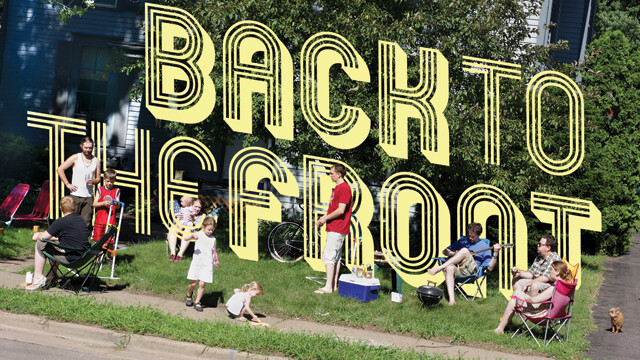
For decades, the public interest in community involvement, neighborhood building, and placemaking the nation over was in decline. Quite simply, our sense of community was dying. So a bunch of experts got together and decided to track down the reasons why. And one of them, believe it or not, is the simple choice of where we relax at home. Our societal flight from the front porch to the back yard has had big effects on our neighborhoods. Thankfully, the articles and research done in recent years has made an impact, and people are making conscious efforts to switch back. With this guide to changing the way you look at your yard, the hope of Volume One is to help spread that shift throughout the Chippewa Valley. So get out front, and help lead the charge to reclaim our neighborhoods.
.
REDISCOVERING THE PORCH
a historical hangout is lost and then found
There was a time when the front porch was the place to be. When nearly every home on every block had a porch the length of their house, complete with comfortable seating and end tables like you’d see in a living room setting. And – get this – they were a popular hangout. People routinely relaxed on their front porches for hours. They’d have a cold beer or pitcher of lemonade and do some reading, eat meals, listen to music, basically take part in any kind of hobby. The point wasn’t what they were doing, but where they were doing it. From their front porch they were able to stay plugged in to their neighborhood or community as the parade of life passed by. They could start conversations with passing acquaintances, or merely notice some behavior patterns and thus glean a little more from the place they live.
By the time cookie-cutter subdivision developments came into style in the 50s (think Leave it to Beaver), front porches gave way to “sun porches,” “breezeways,” “enclosures,” and eventually, just the plain old façade of a garage. What happened? People moved to their backyards. The familial lifestyle had switched to a protective, hermetically sealed atmosphere in which people tried to replicate the safe and “normal” settings of their neighbors and what they saw on TV. What they saw as “conventional” eventually boiled down to a bland, shut-in way of living. People stayed indoors, and when they relaxed outside, it was in a backyard with bushes or fences dotting the property line where they can control who comes in.
Not to demonize the 50s (after all, those people experienced the Great Depression and two world wars), but we’ve realized their generational folly and the proverbial fence gate is now swinging the other direction. Front porches and stoops are now back in fashion, but not as a status symbol so much as a hangout. Many new homes and urban structures are adding them back on as people reclaim their interest in the world around them, specifically their neighborhood and community.
In the Project for Public Spaces’ Great Neighborhood Book, they credit Minneapolis as one of the places making this progressive move. Author Jay Walljasper talked with a family that built a second-story patio that they liked, but made them feel cut off from the neighborhood. So they built a front deck and put out a fire pit, moves they would later say changed their lives. The book also mentions an arts organization that built green Adirondack chairs and gave them away to people who promised to put them in their front yards and lounge in them. Also, the puppetry performance group Open Eye Figure Theatre did a summer tour that involved front yard performances in neighborhoods where all the kids in the area could gather and watch a show.
In short, people are realizing the placemaking potential of a simple thing like a yard.
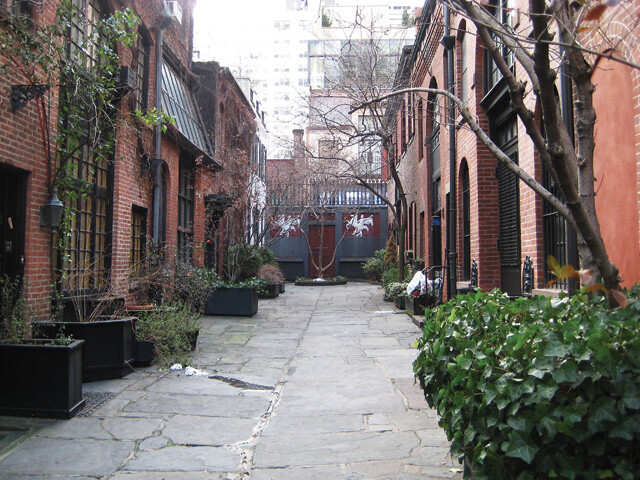
MAKING ENEMIES OF ALLEYS
the disappearance of another neighborhood integrator
Around the same time porches were standards in universal design, so too were alleyways on neighborhood blocks. Often built to provide rear access to your home (where your garage was) and give service vehicles access (because your garbage was there, too), these alleys were either roughly paved or composed of gravel/dirt. Many now think of them as run-down areas, but that’s only because they were no longer common practice after the 50s (thus falling on the priorities list), when driveways and garages moved up and backyards became more private.
But some, like famed architect and urban planner Andrés Duany (who wrote Suburban Nation: The Rise of Sprawl and Decline of the American Dream) have long insisted that alleys better integrate neighborhoods. This is another shared area where backyards meet and cars/pedestrians travel, so one in which you’ll touch base with neighbors.
Some will hear the word “alleys” and think of dark and dodgy areas where illegal activities would take place. That’s because we put up bushes and fences to shut ourselves in and everything else out. (The out of sight, out of mind principle.) It doesn’t need to be this way.
A simple alley can act as a backyard connector, where spaces feel open and welcome neighbors for conversations, potlucks/barbeques, lawn games, or their kids to play together. And residential alleys aren’t the only ones with potential.
In many European cities, alleyways are thriving marketplaces and gathering areas. In England, for instance, there’s no less than 10 terms for these types of spaces. In Melbourne, Australia, they’re known as laneways, and they are vital corridors known for cafés, bars, and shops.
A famous American example exists in New Orleans’ French Quarter. An area dubbed “Pirates Alley” is a cobblestone pedestrian walkway a mere one block long and running between two historic buildings (a government house and a cathedral). Now many small businesses take residence there, artists set up on special occasions, and it’s also a popular spot for weddings. Another, called Brattle Walk, is in Cambridge, Massachusetts near the Harvard campus. Surrounded by amazing architecture, this place’s charm might be missed simply because it’s aesthetically dwarfed by structures. But they got the small, important stuff, right. Over three decades, independent developers have contributed their little piece to Brattle Walk, now a charming gathering place marked by bustling businesses, market-type vendors, and two buildings touching each other, creating an archway.
Chicago has an amazing 1,900 miles of alleys, and in 2007 the city’s Department of Transportation started re-investing in them by converting the asphalt passages into “Green Alleys.” They install semipermeable concrete where fungi and bacteria can grow, allowing for easier water runoff and groundwater protection, while also showing residents that we haven’t forgotten about the potential of our alleys.
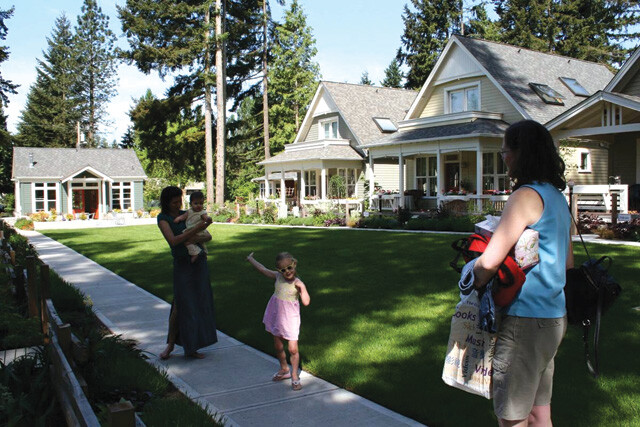
TAKING DOWN BARRIERS
moving away from bushes and fences
There used to be a time when backyards were the place where kids from adjoining houses would come together to play, and crossing between yards wasn’t an issue whatsoever. While each yard retained a private feel in the zones where decks, clotheslines, and grills came into play, overall it was a shared space where kids could play freely outdoors and meet other kids. It’s something fairly rare nowadays (especially in large suburban communities), but some people are making conscious efforts to change that.
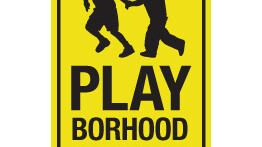 There’s a guy in San Francisco named Mike Lanza who dubbed these spaces “Playborhoods,” and his nostalgia for these spaces is so strong that he transformed his yard into a “public family room” where he annually holds a free-for-all summer camp where he provides the space and materials, and the kids handle their own programming. New York City’s Come Out and Play Festival is a similar initiative, though involves adults much more.
There’s a guy in San Francisco named Mike Lanza who dubbed these spaces “Playborhoods,” and his nostalgia for these spaces is so strong that he transformed his yard into a “public family room” where he annually holds a free-for-all summer camp where he provides the space and materials, and the kids handle their own programming. New York City’s Come Out and Play Festival is a similar initiative, though involves adults much more.
An example somewhat closer to home can be found in Wisconsin Dells, in the front yard of the man credited with starting their first waterparks. Jack Waterman, who started and sold what is now Noah’s Ark and Great Wolf, lives in the best trick-or-treating neighborhood in the Dells. Where the houses go all-out in decorations, many residents make good livings, and more and more families move to every year. It’s a combination of Eau Claire’s East Hill and Third Ward. Several years ago Jack decided to transform a giant chunk of his yard into a shared playground for the kids in the neighborhood. In summer, it’s a baseball diamond with containers for bases, balls, and bats. In fall, it’s a football field (that also works for soccer), again with provided equipment. He maintains it, paints the lines, and even installed an automatic sprinkler system. The parents with homes in that neighborhood are pumped to live there, and saying the kids are psyched is an understatement.
Now most people probably aren’t ready or willing to make that kind of commitment. And others may be behind the front porch movement, but still want to have their private backyard setting. An example of a great compromise is in Seattle. Architect Ross Chapin builds cottage communities with eight fenced backyards that all open (via a door) to a shared commons space with gardens and a building with a workshop and party room. He’s also author of the book Pocket Neighborhoods: Creating Small Scale Communities in a Large Scale World.
Another is in Baltimore, where residents of 11 row homes in the Federal Hill neighborhood tore down their fences and created a tree-shaded courtyard that they share. They added patio tables, landscaped paths, and a terrace to make it inviting and, hopefully, create interaction. The property values have skyrocketed, as they often do, because people are more likely to make improvements to their yard when they spend more time there.
More and more places are making these kinds of changes, and if you want to see more before you change your own yard, visit CommunityGreens.org for success stories and ideas for shared spaces in community blocks.
THE SAFE ROUTE
did you know a front yard culture inherently makes a neighborhood safer?
It may seem like an instinctive deduction made with no actual proof, but making the move to the front yard really does make a place safer. (And if “muzak” is proven to prevent loitering and crime, is this that much of a stretch?)
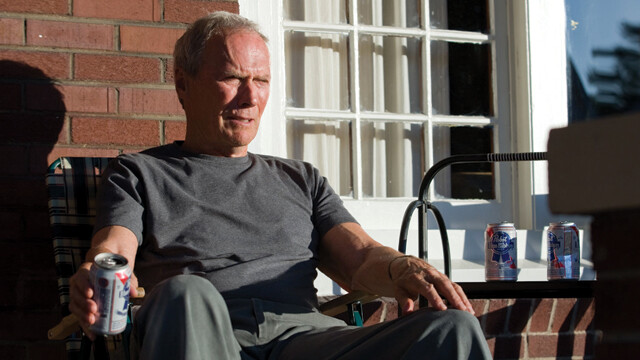
have been if Clint never noticed what happens
around his neighborhood. Think about it!
In Jane Jacobs’ book The Death and Life of Great American Cities, she posits that having people on the streets and sidewalks provides more safety than police cars, surveillance cameras, bright lighting, and burglar alarms. A radical idea when she wrote it in the 60s, but one that has proven bearing now. She said one of the safest neighborhoods at the time was North End Boston, yet city planners thought it a crowded, outdated, and dilapidated area that needed bulldozing like the West End. The North End was a poor area populated by mostly non-whites, which Jacobs asserted to be stereotypical hallmarks of a “bad” neighborhood with high crime. Yet, the area went a few decades without crimes like rapes and muggings on the city streets, and when they did happen, they were immediately thwarted by the many onlookers around the street.
It’s the same concept in a front yard. If people are playing in the front, relaxing on the porch, looking out a bay window, or walking the sidewalk, troublemakers notice. If they think they’re being watched, they don’t act.
Hoping to rid their area of crack dealers, some elderly ladies in a public housing community of Seattle banded together by setting up lawn chairs at the known areas where dealers frequented. They’d knit, read, and chat, all while successfully fighting crime. The neighboring Garfield neighborhood would march on Friday nights for the same purpose.
In Lyndale, a burb of Minneapolis, a group of walkers strolled in the neighborhood and called police whenever they saw something suspicious. A simple task, even more so than a neighborhood watch, but one that brought crime down 40 percent in four years and created the fastest-rising property values in the state. And not only did it deter crime, but they once saved a sleeping woman as her house caught fire, and the effect on their sense of community and neighborly bond is immeasurable.
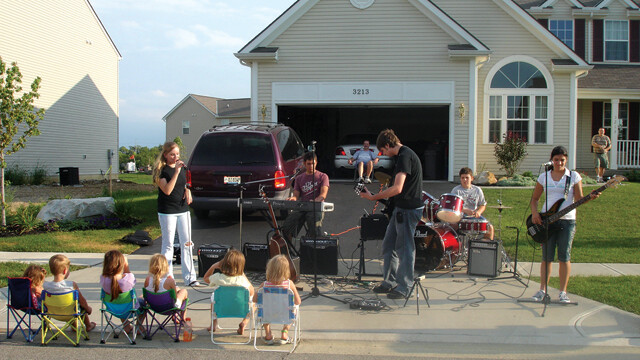
MAKING THE SWITCH
what you can do to become a front yard person
If you understand the concept, are behind it, and are now reading this, congratulations. You’re now a front yard person. Your certificate is in the mail. Now all you have to do is create reasons to relax in your front yard.
Because you can’t just trust yourself to regularly hang out in your front yard. It’s not a matter of telling yourself you’re going to, so much as making yourself do so. Where we relax and recreate is often a reflexive habit, and luckily there’s an easy way to transplant this habit.
Start with things you like to do in your backyard, and ask yourself if that’s something you’d enjoy just as much in front. Is that gardening? Is that sitting in a rocking chair and reading? Is that grilling up some food? There’s nothing wrong with wanting to keep some of your backyard activities right where they are. Your garden might be too awesome to start from scratch someplace else. Your patio, with furniture, might be a better place to do the cooking and eating. And you might be too self-conscious to run through the sprinkler in front. We’re not that naïve or demanding.
But you also don’t have to think exclusively in terms of things you do by yourself. If you’re hoping to get out front to interact with neighbors and connect with the community, what better way than creating shared activities with a neighbor you know and are comfortable with? For instance tossing the fire pit out front and inviting people over. Or playing a yard game like bocce ball or Kubb. Or having a shared garage sale. Or creating a shared garden space. That’s exactly what the residents of Washington Street in Boulder did, as two neighbors sharing a garden quickly became eight homes sharing the same space and using the produce for regular potlucks.
This isn’t exclusive to yards, either. If you have a garage out front instead of a porch, and you’re a project-based hobbyist, consider moving your shop up from the basement to the garage. But instead of shutting the world out, leave the door open for conversations and passersby (think of the advertising alone!).
As long as you find at least one thing that will regularly get you out front, you’re in good shape. If you can’t think of something, then you might have to go all out. Maybe consider building something new, which could be as easy as a hammock or as difficult as a gazebo, pergola, or pond.
There’s tons of possibilities, so let your imagination run wild.
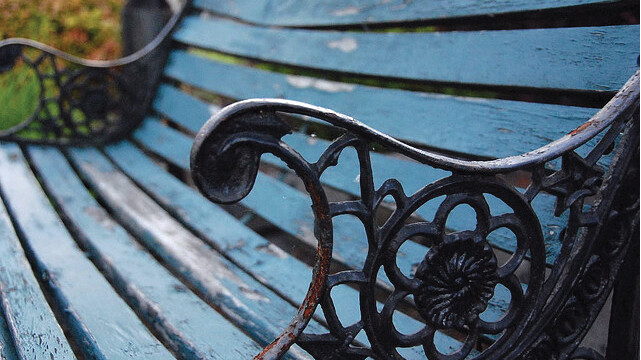
SIDEWALK INTERACTION EXTREME
a “bench” mark success story
After hearing about the move to become more front yard oriented, an Ontario, Canada resident made a fairly odd gesture in his yard. Dave Marcucci started by tearing out all his front yard fencing and got to work on landscaping. His final move: constructing a bench.
Passersby asked why he didn’t build his bench in the backyard, to which he would quickly reply that it’s for them to use, not him. Located right along the sidewalk, the bench soon became a focal point of the neighborhood where people would rest while on a stroll or kids would sit while waiting for the bus. And sometimes he’d sit there, and say “Hi” as people passed. In turn, Dave met loads of people in his neighborhood, and has since inspired others in Mississauga, Ontario to do the same.
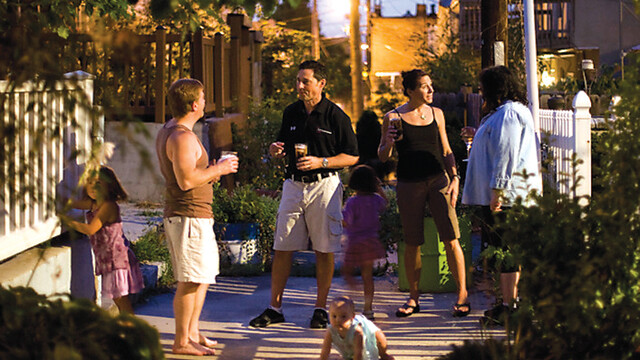
A PLACE WORTH SAVING
a success story of reclaiming back alleys
In Baltimore, the amount of crime became too much for some residents in 2009, who took it upon themselves to install wrought iron gates at either end of their alley. These banded-together neighbors then proceeded to install potted trees, park benches, and gardens in the space, which in turn became a spot for barbeques, parties, and playing kids. According to The Washington Post, “the space blossomed into an open-air living room where neighbors mingle after work, toss parties, and perform jazz. It seems worlds apart from an alley eight blocks north that a gunman used to approach a backyard cookout last summer and wound 12 guests.” Though unanimous consent is hard to get with the stigmas of “gating” anything, nine other blocks in Baltimore had successfully made the change within the following year. Now it is a feather in the cap of a national initiative called Community Greens that removes legal roadblocks at state and local levels for shared spaces like these to happen, and Baltimore was its first “client.”
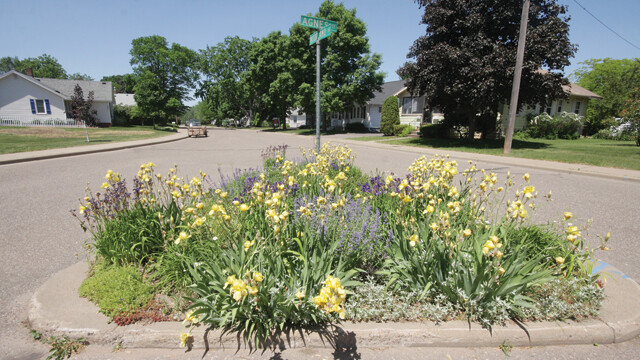
SPREADING OUTSIDE THE YARD
extending neighborhood pride to a median
When Eau Claire’s Agnes Street and Woodland Avenue meet, there’s an odd little median island with a small patch of grass and a street sign. Well in 2001, when Jackie Erickson moved into 1655 Woodland, she decided to make something of it. “I looked at it and thought, ‘I want to make a garden in it,’ ” she said. After getting the OK from the city, Jackie got to work. “But it was like digging into cement, so that first year all I did was plant flowers on the points of it. … Gradually I built it up.” Soon Jackie’s neighbors started pitching in on the watering. Then they purchased flowers to contribute. Then they began a rotation of working on the garden. When Jackie turned 75 a few years ago, she handed over her vision to the neighbors that helped make it a reality. “It just kind of perks up the area a bit. Better than signs and weeds,” Jackie said. “It makes people know we like our little neighborhood.”
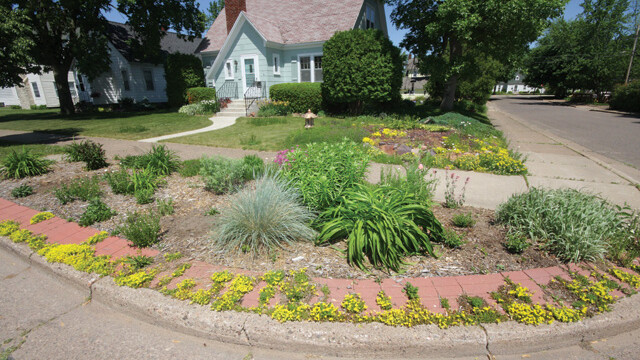
BEAUTIFYING YOUR BOULEVARD
did you know you could?
If you have a sidewalk, chances are you have a boulevard. It’s that chunk of public space between the curb and sidewalk that you have to mow and maintain. Well did you know you’re allowed some degree of personalization when it comes to this space?
According to the City of Eau Claire’s ordinance* on the matter, you’re allowed to “plant and maintain boulevard areas … in a manner that enhances and improves the aesthetic appearance … as an aid to maintaining the sustainability, quality, and livability of the residential neighborhoods.”
THE SPECIFICS
• Plantings such as flowers may not exceed 36 inches in height. If you’re close to an intersection or driveway, the height is 18 inches.
• You can’t grow vegetables there.
• Trees and native grasses are allowed, but have very specific rules about heights and species (look up ordinances 8.20 and 8.28.105 and 8.28.102).
• “Noxious and objectionable weeds” aren’t allowed.
• Growth is not allowed to hang over the sidewalk, curb, or street.
• No planting or digging is allowed until you call Diggers Hotline to ensure you’re not threatening utilities.
• Non-vegetative landscaping materials can’t exceed 50 percent of the abutting property owner’s boulevard area. It also cannot erode, wash, or drain off the boulevard.
• Lawn ornaments aren’t allowed.
• Green practices are encouraged (natural herbicides and pesticides, conserving water, runoff mitigation, etc.)
• If the city accidentally damages items in your boulevard, it’s tough luck.
*Nothing could be found on this matter in the Chippewa Falls ordinances. In Menomonie, however, they allow plantings and are much less specific in their ordinance (Chapter 9.8).
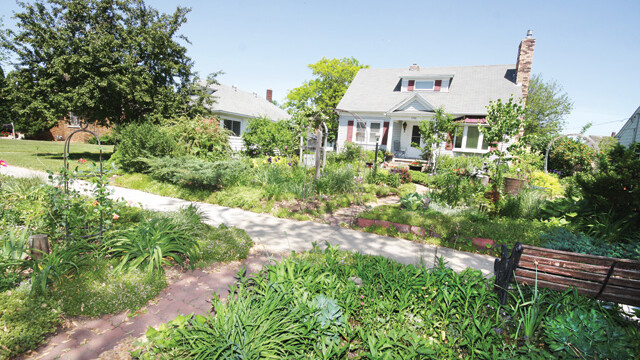
TAKING THE LAW IN HER OWN HANDS
a local woman’s fight to beautify her boulevard
One of the glowing examples of boulevard beautification is Carol Cox’s 1908 Hogeboom Avenue home in Eau Claire. In May of 2009, Carol was one of the locals leading the charge at the city council level to change the boulevard ordinance and allow plantings other than grass. An avid gardener and member of the Master Gardeners, Carol told the council, “I have my gardens both front and back, and I know people come through here, see the boulevard, and go through the back alley to see the rest. I think people enjoy it.” At the time, however, Carol’s boulevard was illegally beautiful (along with a handful of others in the city). “This is attractive and it’s different,” she said. The city changed the ordinance, and now Carol’s boulevard is both strikingly beautiful and perfectly legal. “I think gardeners, especially master gardeners, we’re like rodents,” she said. “We gotta keep digging or I don’t know what happens. I’ve thought of spreading into neighbors’ yards, but … this is a much better option.” In addition to the many variations of plantlife (including daphne burkwoodii, spirea and barberry bushes, redwood and Japanese lilac trees, and perennials like sage and hostas), Carol’s yard also has a bench in her boulevard that faces her house. “Gardens are meant for people to enjoy,” she said. “If someone walks by and clearly is interested in my gardens, I invite them to have a seat.” Since she’s such a dedicated greenthumb, Carol hopes this will draw other active gardeners in for a conversation and a stroll through her yard.






















